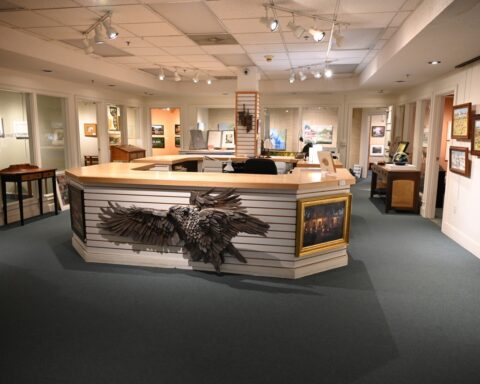By Anne Archer, Vermont Country correspondent.
RUPERT — Inside the coziest of eight rustic cabins used for year-round camping at Merck Forest and Farmland Center in Rupert sits a medium-sized cooler, a wooden bunk, a table, a chair, a woodstove, a makeshift clothesline and art left behind by previous campers.
Outside, an outhouse, dry firewood — if you’re smart enough to know which pile to grab from — and unobstructed vistas of Haystack Mountain to the south and The Gallop to the east help you forget the uphill grind endured to reach a little piece of serenity.

Any time of year, regardless of the elements — rain, snow, sun, mud and wind be damned — Merck’s cabins (this one is called “Viewpoint”) are available for rent. Getting to them requires a hike anywhere from 1 to 3 miles up Old Town Road, a passageway built in the 1700s that connects the north end of the 3,500-acre property to the south.
Old Town Road wanders over ridges and into hollows, acting as the main artery for 35 miles of hiking trails. Splintering off the artery, Barn Cabins, Clark’s Clearing, Nenorod, Dunc’s Place, Spruce, Ridge, Ned’s Place and Viewpoint scatter, waiting to host campers in search of a rustic retreat free from modern amenities like electricity and indoor plumbing.
According to Rob Terry, executive director of Merck, the first cabin on the property was Clark’s Clearing, named after one of the original farmers in the landscape. It was constructed in 1967 by the Nation’s first all-girls youth conservation crew.
Initially, Clark’s, as well as some of the other cabins, began as a lean-to that housed Merck’s interns and summer volunteers, but by the mid-1970s, the use had transitioned into recreational lodging for visitors who pay a fee to enjoy a backcountry experience.
Terry explained the reason for the transition was “to connect people with the land,” a concept pharmaceutical executive George Merck and his wife Serena supported when they donated the property in 1950 to create Vermont Forest Foundation (renamed to Merck Forest and Farmland Center in 1966).
Merck’s eight cabins come with the same amenities — wooden bunks, a table, a chair or two, a woodstove, firewood for heating, a cooler for rodent-free storage of food, and a nearby outhouse — but they are all unique, offering different views, locations and sizes.

If you ask Mike Stock, Merck’s resource management coordinator, he’ll tell you his favorite is Nenorod because, “you have to work at getting here.”
Stock maintains the hiking trails and cabins with the help of local high school interns. The work involves: repairing leaking roofs and malfunctioning woodstoves, supplying wood bins with plenty of firewood, and cleaning up messes left behind by inconsiderate campers. All of this is done with the enthusiasm of 100 trick-or-treaters on Halloween night.
“Smiles everywhere,” Stock said, greeting happy campers during his routine check-in.
In Spruce, a cabin roughly a mile from Joy Green’s Visitor Center, classical music piped out from a cluttered corner as a man finished cleaning up his breakfast dishes. A few books, a journal, a bottle of red wine and miscellaneous camping supplies filled the table.
The man said he’d been camping at Merck off and on for 35 years, first with his wife, then with his wife and children, and on this last stay, alone.
“We have devoted campers,” Stock said. “Some came here with their parents when they were kids, and now, they bring their kids here. Multigenerational campers.”
At Ridge, a secluded cabin with a view that leaves you feeling as if you’re the only person around for hundreds of miles, Stock introduced himself to a mom standing by the picnic table. She smiled, suggesting he stay away from the two barking dogs by her side. Her two young girls played in a creek about a quarter mile down the trail.

Crafts, water containers, bug spray and supplies sat on the window ledges, proving that little spaces are conducive to nesting.
Inside Ned’s Place, the perfect cabin for stargazing while roasting marshmallows over a campfire, Stock points out some artwork left behind by campers — a drawing of spruce trees with mountains in the background and a drawing of Ned’s Place on a smooth white mushroom that once grew on a tree.
Stock said he enjoys reading the logbooks that are kept in each cabin where campers leave friendly comments, helpful suggestions, poems and drawings. Others have built chairs, strung up a clothesline, or donated items like a percolator, frying pans, a handmade strainer and metal grates for cooking food over a fire.
With 3,500 acres to explore, there is more to camping at Merck than nesting in a cabin and crafting from nature.
Hiking abounds on 35 miles of trails, offering dramatic views and opportunities for birdwatching. And just off Old Towne Road, sit Birch and Beebe ponds, great spots to fish for little brook trout.
A 60-acre, ecologically sensitive working farm hosts horses and sheep grazing in fields, pigs resting in the shade, and chickens foraging on insects, grubs, vegetation and seeds. Nearby, blueberry and raspberry patches are ripe for picking during the summer months.
“What is cool about this place,” said Liz Ruffa, Merck’s advancement director, “is it’s still doing what it was originally intended to do.”
Regardless of if you are alone sleeping comfortably in Viewpoint, or if you are bonding with 15 family members or friends at Dunc’s Place, there are plenty of moments for self-reflection and exploration all year round at Merck Forest and Farmland Center.
If you go …
Merck Forest and Farmland Center
3270 Vermont Route 315, Rupert, Vt.
Phone: 802-394-7836
Website: Merckforest.org
Cabins are available for rent year-round. Reservations are required. For booking information, Must-Knows and a helpful packing list, call or visit the website.
Anne Archer lives in Manchester, Vt. She is a regular contributor to the Manchester Journal.












